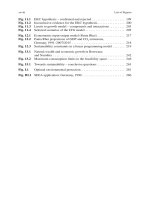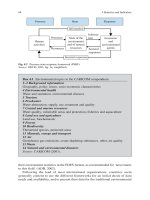- Trang chủ >>
- Khoa Học Tự Nhiên >>
- Vật lý
deadly companions how microbes shaped our history dec 2007
Bạn đang xem bản rút gọn của tài liệu. Xem và tải ngay bản đầy đủ của tài liệu tại đây (4.05 MB, 265 trang )
Deadly Companions
This page intentionally left blank
Deadly Companions
How Microbes Shaped Our History
DOROTHY H. CRAWFORD
1
3
Great Clarendon Street, Oxford ox2 6dp
Oxford University Press is a department of the University of Oxford.
It furthers the University’s objective of excellence in research, scholarship,
and education by publishing worldwide in
Oxford New York
Auckland CapeTown Dar es Salaam Hong Kong Karachi
Kuala Lumpur Madrid Melbourne Mexico City Nairobi
New Delhi Shanghai Taipei Toronto
With offices in
Argentina Austria Brazil Chile Czech Republic France Greece
Guatemala Hungary Italy Japan Poland Portugal Singapore
South Korea Switzerland Thailand Turkey Ukraine Vietnam
Oxford is a registered trade mark of Oxford University Press
in the UK and in certain other countries
Published in the United States
by Oxford University Press Inc., New York
ß Dorothy H. Crawford 2007
The moral rights of the author have been asserted
Database right Oxford University Press (maker)
First published 2007
All rights reserved. No part of this publication may be reproduced,
stored in a retrieval system, or transmitted, in any form or by any means,
without the prior permission in writing of Oxford University Press,
or as expressly permitted by law, or under terms agreed with the appropriate
reprographics rights organization. Enquiries concerning reproduction
outside the scope of the above should be sent to the Rights Department,
Oxford University Press, at the address above
You must not circulate this book in any other binding or cover
and you must impose the same condition on any acquirer
British Library Cataloguing in Publication Data
Data available
Library of Congress Cataloging in Publication Data
Data available
Typeset by SPI Publisher Services, Pondicherry, India
Printed in Great Britain
on acid-free paper by
Clays Ltd, St Ives plc
978-0-19-280719-9
13579108642
Contents
List of Figures and Tables vii
Preface ix
Acknowledgements xiii
Introduction 1
1. How It All Began 9
2. Our Microbial Inheritance 29
3. Microbes Jump Species 54
4. Crowds, Filth and Poverty 82
5. Microbes Go Global 112
6. Famine and Devastation 139
7. Deadly Companions Revealed 161
8. The Fight Back 184
Conclusion: Living Together 211
v
Glossary 216
Notes and References 228
Further Reading 238
Index 241
contents
vi
Figures and Tables
figures
0.1 Relative sizes of organisms and their component parts xi
0.2 SARS in Hong Kong 4
1.1 Incidence of West Nile fever in the USA, 1999–2004 20
1.2 R
0
: the basic reproductive number of an epidemic 22
2.1 Malaria parasite life cycle 39
3.1 Notification of measles cases in UK from 1963 to 1976 62
3.2 Drawings from the Ebers papyrus possibly depicting
haematuria caused by schistosomiasis 70
3.3 An illustration of a penile sheath worn in Ancient Egypt,
circa XIX Dynasty. 1350–1200bc 71
3.4 Schistosomiasis: transmission cycle of
Schistosomiasis mansoni 73
4.1 Map showing the advance of the Black Death 87
4.2 Map of present day plague foci worldwide 93
4.3 Plague cycles 98
5.1 Title page from Bartholomew Steber’s Syphilis,
1497 or 1498 126
5.2 Cholera: a map showing its pandemic spread, 1959–94 132
vii
5.3 Cholera: the natural and epidemic cycles of Vibrio cholera 136
6.1 A section of a leaf showing the potato blight fungus
growing and producing spores (Berkley 1846) 150
8.1 Population growth, 8000 bc–ad 1974 185
8.2 MRSA in England and Wales, 1989–2004 196
8.3 Worldwide distribution of TB 200
8.4 Geographical distribution of malaria worldwide 203
8.5 The emergence of pandemic Xu virus strains after
reassortment in a pi g 206
tables
1.1 R
0
values for human and animal microbes 23
3.1 Examples of species domesticated in different areas
of the world 57
8.1 A sample of human pathogens which have
emerged since 1977 187
list of figures and tables
viii
Preface
Microbes first appeared on planet Earth around 4 billion years
ago and have coexisted with us ever since we evolved from our
ape-like ancestors. By colonizing our bodies these tiny creatures
profoundly influenced our evolution, and by causing epidemics
that killed significant numbers of our predecessors they helped to
shape our history. Through most of this coexistence our ancestors
had no idea what caused these ‘visitations’ and were powerless to
stop them. Indeed the first microbe was only discovered some
130 years ago and since then we have tried many ingenious ways
to stop them from invading our bodies and causing disease. But
despite some remarkable successes, microbes are still responsible
for 14 million deaths a year. In fact new microbes are now
emerging with increasing frequency, while old adversaries like
tuberculosis and malaria have resurged with renewed vigour.
This book explores the links between the emergence of
microbes and the cultural evolution of the human race. It com-
bines a historical account of major epidemics with an up-to-date
understanding of the culprit microbes. Their impact is discussed in
the context of contemporary social and cultural events in order to
ix
show why they emerged at particular stages in our history and
how they caused such devastation.
We begin with SARS, the first pandemic of the twenty-first
century. Then we travel back in time to the origin of microbes
and see how they evolved to infect and spread between us with
such apparent ease. From there we follow the interlinked history
of man and microbes from the ‘plagues’ and ‘pestilence’ of ancient
times to the modern era, identifying key factors in human cultural
changes from hunter-gatherer to farmer to city-dweller which
made us vulnerable to microbe attack.
The final chapters show how modern discoveries and inven-
tions have impacted on today’s global burden of infectious diseases
and ask how, in an ever more crowded world, we can overcome
the threat of emerging microbes. Will pathogenic microbes be
‘conquered’ by a ‘fight to the death’ policy? Or is it time to take
a more microbe-centric view of the problem? Our continued
disruption of their environment will inevitably lead to more
conflict with more microbes, but now that we appreciate the
extent of the problem surely we can find a way of living in
harmony with our microscopic cohabitants of the planet.
Throughout this book the term ‘microbe’ is used for any
organism that is microscopic, be it a bacterium, virus, or proto-
zoan (Figure 0.1). Fungi are also included since although their
vegetative growth is often visible to the naked eye, the spores that
spread them from one host to another are microscopic. None of
these tiny life forms have brains, so despite the fact that they often
appear ingenious and manipulative, they have no facilities to think
or plan. The human characteristics often attributed to them
actually come about by their ability to adapt rapidly to changing
situations. Then the natural process of ‘survival of the fittest’
ensures that the best adapted prosper, so that in the end they really
preface
x
Figure 0.1 Relative sizes of organisms and their component parts
Source: J. G. Black, Microbiology, Principles and Exploration, 5 th edn ß 2002, Fig. 3.2; reprinted with permission of John Wiley & Sons, Inc.
do seem to lie in wait for a suitable host and then ‘jump’, ‘attack’,
‘invade’ and ‘target’. Although these descriptions seem apt and
are frequently used in the text of this book to illustrate the lives
of microbes, in reality microbes are not capable of malice afore-
thought.
Wherever possible the scientific terms used in the book are
defined in the text, but there is also a glossary at the end which
provides additional information.
xii
preface
Acknowledgements
This book could not have been written without help and support
from many people to whom I am e xtre mely grateful. In particular
I thank my editor, L atha Menon, for her help and encouragement,
and the following colleagues for providing expert information and
advice: Professor Sebastian Amyes (antibiotic resistance), Dr Tim
Brooks (plague), Dr Helen Bynum (historical events), Professor
Richard Carter (malaria), Dr Gareth W Griffith (potato blight),
Professor Shiro Kato (smallpox in Japanese cultural history), Dr
Francisca Mutapi (schistosomiasis), Dr G Balakrish Nair (cholera),
Professor Tony Nash (flu), Dr Richard Shattock (potato blight),
Professor Geoff Smith (smallpox), Dr John Stewart (bacteria),
Dr Sue Welburn (trypanosomiasis), Professor Mark Woolhouse
(epidemiology). In addition I am grateful to the following for reading
and commenting on the manuscript: Danny Alexander , W illiam
Alexander, Martin Allday, Roheena Anand, Jeanne Bell, Cathy
Boyd, Rod Dalitz, Ann Guthrie, Ingo Johannessen, Karen McAulay,
J. Alero Thomas.
I am also indebted to Dr Ingo Johannessen for virological research,
John and Ann W ard for organizing a visit to Eyam, Elaine Edgar
xiii
for literature research, Sir Anthony Epstein for facilitating research
on the history of smallpox, and Dr Tasnim Azim for hosting my
visit to the International Centre for Diarrhoeal Disease Research,
Bangladesh.
Finally, I thank the University of Edinburgh for granting me a
sabbatical year to research and write the manuscript.
xiv
acknowledgements
Introduction
W
hen SARS first hit an unsuspecting world in 2003 the press
had no need to dramatize or embellish. The true story
certainly rivalled any modern thriller with a mysterious killer virus
on the loose in Southern China, innocently carried in a human
incubator to its international launch pad in Hong Kong. From
there the virus jetted round the world infecting over 8,000 people
in twenty-seven countries. Eight hundred people died before the
virus was eventually brought under control four months later.
The whole alarming episode began in November 2002
with an outbreak of an untreatable ‘atypical pneumonia’ in the
city of Foshan in Guangdong province, China, and by January 2003
similar cases were turning up in Guangdong’s capital city, Guang-
zhou. The virus was probably transported there by a travelling
seafood merchant who was admitted to the city’s hospital and
sparked a major outbreak there. By the time the World Health
Organisation (WHO) got to hear about it just three months after
the start of the epidemic, there had been 302 cases and at least five
deaths—too late to stop it snowballing out of control.
At first the microbe spread only locally within China, but in
February 2003, after a sixty-five-year-old doctor who worked
1
in a hospital in Guangzhou arrived in Hong Kong to attend
a wedding, it went global. The doctor checked into room 911 on
the ninth floor of the Metropole Hotel and by the time he was
admitted to hospital twenty-four hours later he had infected at least
seventeen others in the hotel. These people then departed to their
various destinations, carrying the virus with them to five separate
countries and spawning major epidemics in Vietnam, Singapore
and Canada. The chain of infection widened as they passed the
virus on in hospitals, clinics, hotels, workplaces, homes, trains, taxis
and aeroplanes; a single virus-carrying passenger on one flight
infected twenty-two of the 119 other travellers.
SARS (severe acute respiratory syndrome) begins with a flu-like
illness, but instead of improving after a week or so it progresses to
pneumonia. Sufferers feel feverish and increasingly breathless, with
a persistent cough, as the virus colonizes the air sacs of the lungs,
damaging their delicate lining and filling them with fluid. By the
time they seek medical help many are fighting for breath and are
immediately shipped to intensive care units for mechanical venti-
lation. The cough generates a spray of tiny virus-laden mucus
droplets, so anyone in the vicinity is in danger of picking up the
infection. Family members are at high risk; and before the danger
was appreciated many health-care workers, were among the casu-
alties, after struggling to save lives by clearing airways, artificially
ventilating and resuscitating patients.
A young Hong Kong resident who visited a friend at the Metro-
pole Hotel on the day the SARS-infected doctor was in residence
was later admitted to Hong Kong’s Prince of Wales Hospital, where
he started an outbreak among doctors, nurses, students, patients,
visitors and relatives that eventually resulted in 100 cases. One of
these carried the virus to Amory Gardens, a private housing estate in
Hong Kong, where it spread like wildfire. Over 300 people on the
introduction
2
estate caught the infection and forty-two died. Although SARS
is mainly spread by coughing, the virus is excreted in faeces and since
most SARS victims develop watery diarrhoea this is another
possible route of infection. In fact diarrhoea was a prominent feature
among the Amory Gardens SARS victims, and some experts think
the unprecedented attack rate there was caused by a partially blocked
sewage system which, combined with strong exhaust fans in
the toilets, created a rising plume of contaminated warm air in the
airshaft that spread to living quarters throughout the building.
1
Thus
the epidemic in Hong Kong took off, infecting some 1,755 people
before it was brought under control (Figure 0.2).
Meanwhile the v irus ar rived in the US and Canada, seeded directly
from the Metropole Hotel in Hong Kong. And although it did not
spread in the US, the virus took hold in Toronto before doctors
realized what was happening. Six of the first ten cases were from the
family of an elderly couple who stayed at the Metropole Hotel (ninth
floor) while visiting their son in Hong Kong. Their family doctor
became the seventh victim and although she recovered, an elderly
man who happened to be in the hospital emergency department at
the same time as one of the f amily caught the virus and died.
2
The
microbe then moved out into the Greater Toronto area, infecting
438 and killing forty-three before its spread was finally halted.
Dr Carlo Urbani, a WHO infectious disease expert working
with a team from Medecins sans Frontie
`
res at the French Hospital
in Hanoi, Vietnam, was among the first to recognize SARS as a
new and dangerous infection and to note its high rate among
health-care workers, who accounted for thirty of the first sixty
cases in Hanoi. By warning the world of its dangers they ensured
instigation of the necessary precautions worldwide, but sadly it was
too late for Dr Urbani. He felt the ominous symptoms developing
during a flight from Hanoi to Bangkok and alerted the authorities
introduction
3
on his arrival. He battled with the virus for eighteen days in a
makeshift isolation room in Bangkok hospital but died at the end of
March.
3
Five of his colleagues also fell victim to the disease.
WHO’s global health alert issued on 12 March caused long-
unused traditional public health measures to swing into action.
These included routine isolation of SARS cases and quarantine for
anyone who had contacted a case to prevent spread in hospitals,
while travel restrictions with country entry and exit screening
were imposed to interrupt the microbe’s spread in the commu-
nity. These precautions, along with a high-profile media aware-
ness campaign, brought the pandemic under control by July 2003.
But before the whole episode was over there was a final sting in
the tail. In late 2003 the virus jumped to two laboratory workers,
120
100
80
60
40
20
0
15/2
18/2
21/2
24/2
27/2
2/3
5/3
8/3
11/3
14/3
17/3
20/3
23/3
26/3
29/3
1/4
4/4
7/4
10/4
13/4
16/4
19/4
22/4
25/4
28/4
Date of onset (2003)
Number of cases
1/5
4/5
7/5
10/5
13/5
16/5
19/5
22/5
25/5
28/5
31/5
3/6
Figure 0.2 SARS in Hong Kong
Source: I. T. S. Yu and J. J. Y. Sung, ‘The Epidemiology of the Outbreak of Severe Acute
Respiratory Syndrome (SARS) in Hong Kong – What We Know and What We Don’t’,
Epidemiology and Infection, vol. 132 (2005) (Cambridge University Press, 2005), pp 781–6.
introduction
4
one in Singapore, the other in Taiwan, while they were handling it.
Fortunately these infections were not fatal and there was no
further spread, but then in spring 2004 two more laboratory
workers, this time in Beijing, developed SARS, precipitating an
outbreak of six further cases and one death.
By the end of the pandemic there had been over 8,000
SARS cases and 800 deaths involving thirty-two countries. Worst
affected was China with two thirds of cases and one third of deaths.
Despite the death toll the whole episode must be regarded as a
victory for those who worked so hard to contain the microbe;
it could have been a lot worse. As it was, it cost an estimated
140 billion US dollars, mostly from reduced travel to, and invest-
ment in, Asia.
In contrast to the rather medieval-sounding quarantine meas-
ures that were needed to curtail the spread of the SARS virus, the
search for the culprit used twenty-first-century molecular tech-
nology and was accomplished with amazing speed. A coronavirus
(so-called because of its crown-like structure) was identified in
SARS victims by the end of March 2003 and confirmed to be the
cause by the middle of April, just two months after the doctor in
Hong Kong initiated its global spread.
These days a completely new human microbe like the SARS
coronavirus is most likely to be a zoonosis—an animal microbe
that has jumped from its natural host to humans. And since more
than a third of the early SARS sufferers in Guangdong were food or
animal handlers, scientists hunting for its origin headed for the
wet markets of Guangdong, where wild animals are sold live for
the table. Armed with molecular probes they found a SARS-like
coronavirus which was virtually identical to the pandemic virus
strain in several species, but most often in the Himalayan masked
palm civet cat, a member of the mongoose family, which is farmed
introduction
5
in the area.
4
Fortunately these animals are not very widespread in
the wild, but many experts suspect they are not the virus’s natural
host. They could just have acted as a go-between, picking the
virus up from an unknown wild animal and passing it on to
humans; so the natural reservoir of the virus in the wild is still
uncertain.
Blood tests show evidence of past SARS infection in 13 per
cent of Guangdong wet-market traders and animal handlers,
5
indicating that the coronavirus has jumped to humans living in
this area before, and suggesting that it is likely to do so again.
Indeed four new cases appeared in China in January 2004, and
although they were relatively mild and did not spread further,
they are a reminder that the virus is still out there waiting for
another opportunity to pounce.
SARS was the first pandemic microbe of the twenty-first
century, but it will certainly not be the last. Ever since HIV
emerged over thirty years ago we have witnessed increasing num-
bers of new microbes, which are now hitting us at an average of
one a year. While the SARS pandemic may be a preview of what is
to come, it also gives us a glimpse of what our ancestors suffered
over thousands of years: unpredictable epidemics caused by lethal
microbes appearing out of the blue, killing indiscriminately and
spreading fear and panic. We were fortunate in knowing how
to stop SARS, but, as this book illustrates, our predecessors were
not so lucky and the consequences were sometimes devastating.
In later chapters we will look at well-known epidemic microbes
such as bubonic plague and smallpox, as well as lesser-known
killers such as the trypanosome and schistosome parasites. We
will see how and why these and other microbes rose to promin-
ence at different stages in our cultural history and the profound
effect they had on the lives of our ancestors. But first, back to the
introduction
6
dawn of time to track the origin and evolution of killer microbes,
to see how they spread and invade our bodies, and how our
immune system responds to the challenge.
introduction
7
This page intentionally left blank
1
How It All Began
W
hen our solar system Wrst formed some 4.6 billion years
ago planet Earth was a very unfriendly place. Rather like
the planet Venus today, Earth was so hot that carbon dioxide gas
bubbled from molten rock and Wlled the atmosphere, causing such
a massive greenhouse eVect that the planet literally boiled dry. No
living organism could survive under those conditions. But when
Earth had cooled suYciently for water vapour to liquefy just
under 4 billion years ago, life appeared on the planet. This was
not life as we know it today, but molecules that could replicate to
produce daughter molecules with inherited characteristics. Dar-
winian evolution was set in motion and eventually microscopic
single-celled organisms evolved.
These early life forms had to withstand Earth’s highly volatile
atmosphere with toxic gases spewing from erupting volcanoes,
dramatic electrical storms and the sun’s unscreened ultraviolet rays
all promoting uncontrolled electrochemical and photochemical
reactions. The microbes around at this time probably resembled
today’s ‘extremophiles’, a type of bacteria so-called because they
thrive in all the particularly hostile corners of the globe. Extre-
mophiles inhabit acid lakes, hyper-saline salt marshes and the
9
superheated water issuing from hot vents at the bottom of the
deepest ocean trenches where they survive temperatures up to
1158C and 250 atmospheres of pressure. They lie buried 4 kilo-
metres deep in the polar ice caps, and lurk in rocks up to 10
kilometres below ground. Indeed it is possible that life began with
microbes in rocks deep underground, where the heat is intense
and there is an ample supply of water and chemicals to get the
whole process started.
Extremophiles often congregate in coral-like structures called
stromatolites, also known as microbial ‘mats’ because from the
outside they look like doormats; Xat, brown and hairy. These are
home to thriving communities of interdependent microbes, each
utilizing another’s waste to produce energy in a self-sustaining
food chain or micro-ecosystem. Today, microbial mats can still be
seen in corners of the world such as Yellowstone Park, Wyoming,
USA, lakes fed by ancient aquifers in North Mexico, and along
the shores of Western Australia, where the water is rich in chem-
icals and undisturbed by other forms of life. Ancient layered rock
structures found in these places are thought to represent the
fossilized remains of stromatolites that dominated aquatic ecosys-
tems in the Archean eon (2.5 billion to 4 billion years ago).
For around 3 billion years bacteria had Earth all to them-
selves and they diversiWed to occupy every possible niche. At
this stage there was no oxygen in the atmosphere so they evolved
many diVerent ways of unlocking the energy bound up in rocks,
utilizing chemical compounds of sulphur, nitrogen and iron.
Then around 2.7 billion years ago a group of innovative microbes
called the cyanobacteria (previously called blue-green algae) learnt
the trick of photosynthesis, using sunlight to convert carbon
dioxide and water into energy-rich carbohydrates. As a result,
oxygen, a waste product of this reaction, slowly accumulated in
10
how it all began









